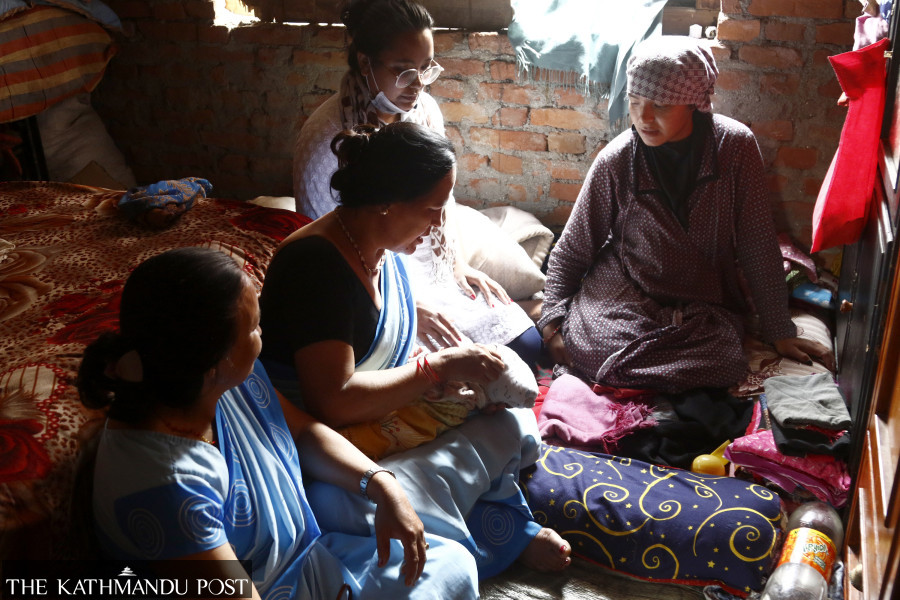Health
Female community health volunteers are unsung heroes
Improved health indicators in Nepal are largely credited to the over 54,000 of volunteers who have worked tirelessly for decades.
Arjun Poudel
A few months ago, Binita Maharjan, a community health volunteer from Kathmandu Metropolitan City’s ward 13, accompanied a woman to a hospital carrying her nine-month-old baby. The rag-picker residing near the Kalimati bridge was ailing and her baby had never taken a dose of vaccine on the regular immunisation drive.
“The woman, who did not seek treatment due to lack of money, was admitted to the hospital and her baby was administered routine vaccines,” Maharjan said.
Maharjan is among the 54,423 female community health volunteers (FCHV) serving throughout the country who work as a bridge between the health facilities and local people.
Not only in the immunisation programme, but those samaritans have also been playing an important role in reducing maternal mortality, child mortality, nutrition, family planning, adolescent health, control of communicable and non-communicable and vector-borne diseases, awareness drive, and health-related campaigns, among others.
Maharjan, who has been working as an FCHV for the last 21 years, followed up until all vaccines on the regular immunisation list were administered to the baby. She said that she had found 15 other babies of people residing in slums who either had not received a single dose of vaccine or had completed regular vaccine doses. The government provides 13 types of vaccines through the national immunisation programme.
The Nepal Demographic and Health Survey-2022, carried out by the Ministry of Health and Population, showed that at least four percent of the children aged 12 to 23 months have received no vaccines. Doctors say unvaccinated children pose a serious risk for an outbreak of vaccine-preventable diseases, which could increase child deaths.
Taradevi Manandhar, another FCHV in the Kathmandu metropolis, said that she regularly visits slums and squatter settlements to check if all children got inoculated with essential vaccines and all pregnant women have taken antenatal care.
“One may think that people in the big cities do not need the help of FCHVs as people take doctor’s service but things are completely different than this,” said Manandhar, who is 67 years old. “A lot of people residing in the city’s slums have been deprived of basic health care services.”
Manandhar, who has been serving as FCHV for the last three decades, was also nominated ward member once and elected twice, added that she and other volunteers have not gotten the recognition they deserve for their services.
“After three decades of service, I am retiring, without getting anything,” Maharjan said. “We even do not get proper recognition from authorities concerned.”
Officials at the Ministry of Health and Population say that FCHVs are the backbone of the country’s health system, to which hundreds of thousands still do not have access. They conceded that FCHVs have to carry out more responsibilities than any other health workers for little to no incentives.
“We cannot imagine the achievements we have made in the health sector without the help of our FCHVs,” said Dr Dipendra Raman Singh, additional secretary for health. “And without their help, achieving the targets of the Sustainable development goals is impossible.”
The Health Ministry provides Rs12,000 to each volunteer for uniforms and an additional Rs12,000 encouragement allowance every year. Apart from this, the federal government bears 50 percent cost of health insurance to the volunteers. The provincial government of the Bagmati Province has decided to bear 50 percent cost of health insurance of FCHVs and provide Rs5,000 to each from this year.
“Given contributions of our FCHVS, amounts and incentives we have been providing are paltry,” said Dr Anup Bastola, deputy director general at the Department of Health Services. “It’s high time we addressed genuine concerns of female community health volunteers.”
Most of the health programmes which have active involvement of female community health volunteers have had a huge success rate.
Nepal successfully reduced the maternal mortality rate from 539 in 1996 to 239 in 2016—for which the country received the Millennium Development Goal award. This achievement would not have been possible if not for the hard work of female community health volunteers.
Vitamin A supplement and de-worming programmes have over 90 percent coverage rate, while the prevalence of communicable diseases like diarrhoea, typhoid, and jaundice has significantly declined.
Likewise, the decline in population growth is also credited to the availability of contraceptives in which health volunteers have played a crucial role.
Moreover, the mothers’ groups under such health volunteers also played a crucial role in empowering women and mitigating violence against them.




 7.12°C Kathmandu
7.12°C Kathmandu













%20(1).jpg&w=300&height=200)
